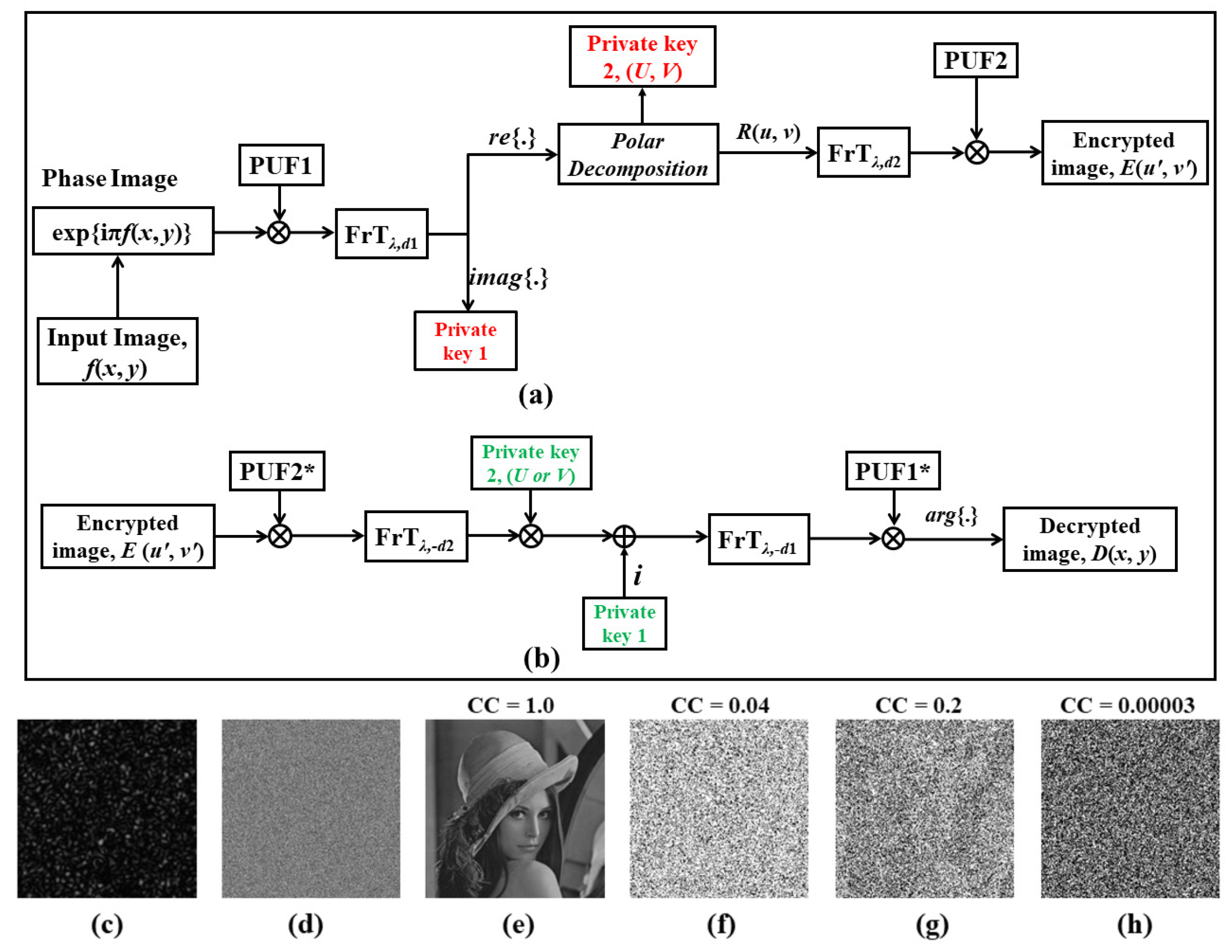An Asymmetric Optical Cryptosystem Using Physically Unclonable Functions in the Fresnel Domain †
Abstract
:1. Introduction
2. Proposed Technique and Results
3. Concluding Remarks
Author Contributions
Funding
Institutional Review Board Statement
Informed Consent Statement
Data Availability Statement
Conflicts of Interest
References
- Refregier, P.; Javidi, B. Optical Image Encryption Based on Input Plane and Fourier Plane Random Encoding. Opt. Lett. 1995, 20, 767–769. [Google Scholar] [CrossRef] [PubMed]
- Nischal, K.N. Optical Cryptosystems; IOP Publishing Ltd.: Bristol, UK, 2020; pp. 2-1–2-18. [Google Scholar]
- Javidi, B.; Carnicer, A.; Yamaguchi, M.; Nomura, T.; Pérez-Cabré, E.; Millán, M.S.; Markman, A. Roadmap on Optical Security. J. Opt. 2016, 18, 083001. [Google Scholar] [CrossRef]
- Kumar, R.; Quan, C. Asymmetric multi-user optical cryptosystem based on polar decomposition and Shearlet transform. Opt. Lasers Eng. 2022, 120, 118–126. [Google Scholar] [CrossRef]
- Vantiha, P.; Manupati, B.; Muniraj, I.; Anamalamudi, S.; Reddy, S.G.; Singh, R.P. Augmenting Data Security: Physical Unclonable Functions for linear canonical transform based cryptography. Appl. Phys B 2022, 128, 183. [Google Scholar] [CrossRef]

Disclaimer/Publisher’s Note: The statements, opinions and data contained in all publications are solely those of the individual author(s) and contributor(s) and not of MDPI and/or the editor(s). MDPI and/or the editor(s) disclaim responsibility for any injury to people or property resulting from any ideas, methods, instructions or products referred to in the content. |
© 2023 by the authors. Licensee MDPI, Basel, Switzerland. This article is an open access article distributed under the terms and conditions of the Creative Commons Attribution (CC BY) license (https://creativecommons.org/licenses/by/4.0/).
Share and Cite
Cris Mandapati, V.; Prabhakar, S.; Vardhan, H.; Kumar, R.; Reddy, S.G.; Sakshi; Singh, R.P. An Asymmetric Optical Cryptosystem Using Physically Unclonable Functions in the Fresnel Domain. Eng. Proc. 2023, 34, 8. https://doi.org/10.3390/HMAM2-14124
Cris Mandapati V, Prabhakar S, Vardhan H, Kumar R, Reddy SG, Sakshi, Singh RP. An Asymmetric Optical Cryptosystem Using Physically Unclonable Functions in the Fresnel Domain. Engineering Proceedings. 2023; 34(1):8. https://doi.org/10.3390/HMAM2-14124
Chicago/Turabian StyleCris Mandapati, Vinny, Shashi Prabhakar, Harsh Vardhan, Ravi Kumar, Salla Gangi Reddy, Sakshi, and Ravindra P. Singh. 2023. "An Asymmetric Optical Cryptosystem Using Physically Unclonable Functions in the Fresnel Domain" Engineering Proceedings 34, no. 1: 8. https://doi.org/10.3390/HMAM2-14124
APA StyleCris Mandapati, V., Prabhakar, S., Vardhan, H., Kumar, R., Reddy, S. G., Sakshi, & Singh, R. P. (2023). An Asymmetric Optical Cryptosystem Using Physically Unclonable Functions in the Fresnel Domain. Engineering Proceedings, 34(1), 8. https://doi.org/10.3390/HMAM2-14124






